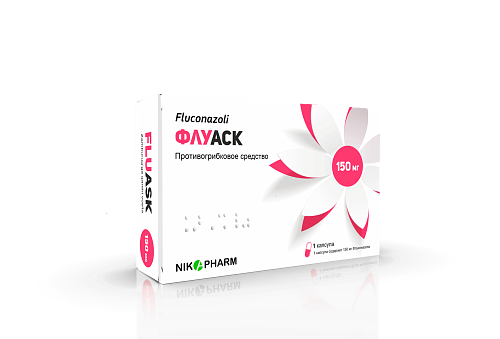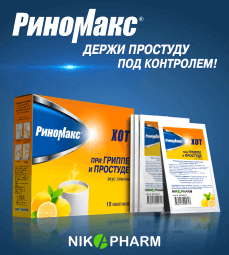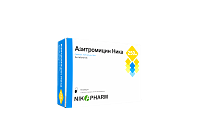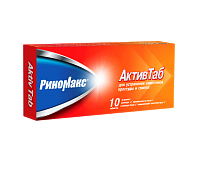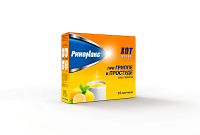Indications
- cryptococcosis, including cryptococcal meningitis and infections of other localizations (e.g. lungs, skin), including in patients with normal immune response and AIDS patients, transplant recipients and patients with other forms of immunodeficiency; maintenance therapy to prevent recurrence of cryptococcosis in AIDS patients;- generalized candidiasis, including candidemia, disseminated candidiasis and other forms of invasive candidal infection, such as infections of the peritoneum, endocardium, eyes, respiratory and urinary tracts, including in patients with malignant tumors, in intensive care units and receiving cytotoxic or immunosuppressive agents, as well as in patients with other factors predisposing to the development of candidiasis;
- candidiasis of mucous membranes, including mucous membranes of the oral cavity and pharynx, esophagus, non-invasive bronchopulmonary infections, candiduria, cutaneous-mucous and chronic atrophic oral candidiasis (associated with wearing dentures), including in patients with normal and suppressed immune function; prevention of recurrence of oropharyngeal candidiasis in patients with AIDS;
- genital candidiasis; acute or recurrent vaginal candidiasis; prophylaxis to reduce the frequency of recurrent vaginal candidiasis (3 or more episodes per year); candidal balanitis;
- prophylaxis against fungal infections in patients with malignant tumors predisposed to such infections as a result of cytotoxic chemotherapy or radiation therapy;
- Mycoses of the skin, including mycoses of the feet, body, groin, pityriasis, onychomycosis, and cutaneous candidal infections;
- deep endemic mycoses in patients with normal immunity, coccidioidomycosis, paracoccidioidomycosis, sporotrichosis and histoplasmosis.
Information on proper use
How to use and dosage
Oral capsules. The drug is taken whole, without chewing or opening the capsule, regardless of food intake, drinking enough water. Therapy can be started before the results of cultures and other laboratory tests. However, antifungal therapy should be modified accordingly when the results of these tests are known.
When transferring the patient from intravenous to oral administration of the drug or vice versa, no change in the daily dose is required.
The daily dose of Fluask is intended for single administration and depends on the nature and severity of the fungal infection.
Use in adults
Cryptococcosis, cryptococcal meningitis
On the first day, 400 mg is taken. Thereafter, the maintenance dose is 200-400 mg. The duration of treatment is usually at least 6-8 weeks. In life-threatening infections, the daily dose can be increased to 800 mg. Maintenance therapy to prevent recurrence of cryptococcal meningitis in patients at high risk of developing it, the recommended dose is 200 mg indefinitely. The duration of treatment of cryptococcal infections depends on the presence of clinical and mycologic effects
Coccidioidomycosis
The recommended dose is 200-400 mg per day. Duration of treatment is 11-24 months or longer depending on the patient's condition. For the treatment of some forms of infection, especially meningitis, a dose of 800 mg per day may be appropriate.
Invasive candidiasis
Strike dose of 800 mg on the first day. The maintenance dose is 400 mg per day. Usually the recommended duration of candidemia treatment is 2 weeks after the first negative blood culture results and disappearance of signs and symptoms of candidemia.
Candidiasis of mucous membranes
Oropharyngeal candidiasis: shock dose 200-400 mg on the first day, maintenance dose - 100-200 mg per day. Duration of treatment is 7-21 days (until remission is achieved), but can be increased for patients with severe immunodeficiency. Esophageal candidiasis: shock dose 200-400 mg on the first day, maintenance dose - 100-200 mg per day. Duration of treatment is 14-30 days (until remission is achieved), but may be increased for patients with severe immunodeficiency. Candiduria: the recommended dose is 200-400 mg daily for 7-21 days. The duration of treatment may be increased for patients with severe immunodeficiency. Chronic atrophic candidiasis: the recommended dose is 50 mg per day for 14 days. Chronic candidiasis of skin and mucous membranes: the recommended dose is 50-100 mg per day.
Prevention of recurrence of mucosal candidiasis in patients with HIV at high risk of recurrence Oropharyngeal candidiasis, esophageal candidiasis: the recommended dose is 100-200 mg daily or 200 mg 3 times a week. Duration of treatment is not limited for patients with depressed immunity. Prophylaxis of candidal infections in patients with prolonged neutropenia The recommended dosage is 200-400 mg. Treatment should be started a few days before the expected development of neutropenia and continued for 7 days after the neutrophil count rises above 1000/mm 3 . Genital candidiasis Acute vaginal candidiasis, candidal balanitis: the recommended dose is 150 mg once. Treatment and prevention of recurrent vaginal candidiasis (4 or more recurrences per year): the recommended dose is 150 mg once every 3 days. A total of 3 doses (day 1, day 4, and day 7) should be used. Thereafter, a maintenance dose of 150 mg once weekly for 6 months should be used. Dermatomycoses Mycosis of the feet, smooth skin mycosis, inguinal dermatomycosis, candidal skin infections: the recommended dose is 150 mg once a week or 50 mg once a day. The duration of treatment is 2-4 weeks. Treatment of mycosis of the feet may take up to 6 weeks. Variegated lichen planus: the recommended dose is 300-400 mg once a week for 1- 3 weeks or 50 mg daily for 2-4 weeks. Dermatophytic onychomycosis: the recommended dose is 150 mg once weekly. Treatment should be continued until a healthy nail grows in place of the infected nail. It usually takes 3-6 months and 6-12 months for healthy nails to grow back on hands and big toes, respectively. However, the rate of nail growth varies among patients and depends on age. After successful treatment of long-term chronic infections, the shape of the nail sometimes remains altered.
Deep endemic mycoses may require the use of the drug at a dose of 200-400 mg/day. Therapy may last up to 2 years. Duration of therapy is determined individually; it is 11-24 months for coccidioidomycosis, 2-17 months for paracoccidioidomycosis, 1-16 months for sporotrichosis and 3-17 months for histoplasmosis.
Use in children
This dosage form is intended for use in children over 4 years of age. The daily dose for children depends on body weight and pubertal development. The recommended dose is 3 or 6 mg/kg/day. The drug is intended to be taken once a day. The maximum daily dose of 400 mg should not be exceeded. Duration of treatment depends on clinical and mycologic response. Children aged 12 years and older If the use of the drug in adolescents (aged 12 to 17 years) is required, the usual adult doses should be used. Administration of doses of 100 or 200 or 400 mg to adults and doses of 3 or 6 or 12 mg/kg to children results in comparable systemic exposure. The efficacy and safety of fluconazole for the treatment of genital candidiasis in children have not been established. Children aged 4 to 11 years Candida of mucous membranes: the initial dose is 6 mg/kg per day, maintenance dose - 3 mg/kg per day. Invasive candidiasis, cryptococcal meningitis: the drug dose is 6-12 mg/kg per day depending on the severity of the disease. Supportive therapy to prevent recurrence of cryptococcal meningitis in children with high risk of its development: the drug dose is 6 mg/kg per day depending on the severity of the disease. Prophylaxis of candidiasis in patients with immunodeficiency: the drug dose is 3-12 mg/kg per day depending on the severity and duration of induced neutropenia. If it is impossible to use properly in children the dosage form of the drug Fluask in the form of capsules, the possibility of replacement by other dosage forms of the drug (powder for preparation of suspension for oral administration or solution for intravenous administration) in equivalent doses should be considered.
Use in elderly patients
In the absence of signs of renal insufficiency fluconazole is used in the usual dose. In patients with renal insufficiency (creatinine clearance <50 ml/min) the drug dose is adjusted as described below.
Use in patients with renal insufficiency
No dose adjustment is required for a single dose. In patients (including children) with impaired renal function in case of repeated administration of the drug it is necessary to initially administer an impact dose from 50 mg to 400 mg, after which the daily dose (depending on the indication) is set according to the following table (refer to instructions)
Patients on regular dialysis should receive 100% of the recommended dose after each dialysis session. On the day when dialysis is not performed, patients should receive a reduced (depending on creatinine clearance) dose of the drug.
